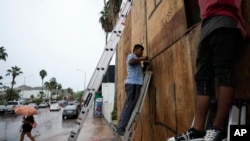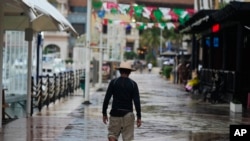Hurricane Norma made landfall near the resorts of Los Cabos at the southern tip of Mexico's Baja California Peninsula on Saturday afternoon.
The U.S. National Hurricane Center said Norma, once a Category 4 hurricane, made landfall as a Category 1 hurricane with winds of 130 kilometers per hour (81 miles per hour) near el Pozo de Cota, west-northwest of Cabo San Lucas. Norma is expected to continue weakening over the weekend as it crosses into the Sea of Cortez, also known as the Gulf of California.
While in the Atlantic, Hurricane Tammy was near Antigua and threatened to batter the islands of the Lesser Antilles.
Earlier on Saturday, businesses in Cabo San Lucas nailed sheets of plywood over their windows, and government personnel posted banners warning people not to try to cross gullies and stream beds after Norma again became a major storm on Friday.
Norma had weakened early Saturday and was downgraded to Category 1 on the hurricane wind scale. By early afternoon Norma was located 24 kilometers (15 miles) west-northwest of Cabo San Lucas, according to the U.S. National Hurricane Center.
The hurricane was expected to continue on that path through the evening before turning to the northeast and slowing down through Monday. The forecast track would take a weakened Norma toward the mainland of Mexico's western Pacific Coast as a tropical storm.
Its languid pace raised the possibility of severe flooding. Norma was expected to dump 15 to 30 centimeters of rain with a maximum of 45 cm in places across southern Baja California and much of Sinaloa state.
John Cangialosi, a senior specialist at the National Hurricane Center, said the area is vulnerable to rain because it's a dry region generally.
He said 45 cm of rain "could result in flash and urban flooding and mudslides."
There were early reports of downed trees and power poles, but no reported injuries or deaths.
The Los Cabos Civil Defense agency urged residents to stay indoors all day as winds and rain increased. Emergency workers worked quickly to evacuate people from low-lying areas and move them to shelters.
Hotels in Los Cabos, which are largely frequented by foreign tourists, remained about three-quarters full and visitors made no major moves to leave en masse, Baja California Sur state tourism secretary Maribel Collins said.
There was no way out anyway: Airports were closed Saturday, according to the local civil defense office.
The local hotel association estimated there were about 40,000 tourists still in Cabo San Lucas and San Jose del Cabo on Friday.
Homero Blanco, the state commander of the National Guard, said beaches at the resort had been ordered closed and Guard troops were sent to clear people from the seashore.
In the Atlantic, the U.S. National Hurricane Center said Hurricane Tammy had winds of 140 kph, (87 mph) and hurricane warnings were issued for the islands of Antigua, Barbuda, Montserrat, and St. Kitts and Nevis, Anguilla, St. Martin and St. Barthelmy.
The storm was about 80 kilometers (50 miles) north of Guadeloupe and 55 kilometers (34 miles) east-southeast of the Caribbean island of Antigua.
Tammy was expected to remain at hurricane strength and even strengthen slightly as it moved toward the Lesser Antilles through Saturday passing by Guadeloupe, Antigua and Barbuda. Both Martinique and Guadeloupe are French overseas departments.
The hurricane center said in a report that "heavy rainfall and flooding (are) likely over much of the Lesser Antilles."
Two weeks after Tropical Storm Philippe rolled through Antigua and Barbuda, dumping 15 to 20 centimeters of rain and plunging both islands into darkness, residents of the islands braced for Tammy's arrival. The slow-moving system was forecast to bring up to 30 cm of rain over a twin island nation where the devastation of Hurricane Irma in 2017 and recent wind damage and flooding from Philippe are still fresh memories.
"This means therefore, that the earth is still somewhat saturated and with additional rainfall, the potential for flooding is elevated," Prime Minister Gaston Browne said in a nationwide broadcast on Friday afternoon. He urged residents to take all necessary steps to secure life and property.






















